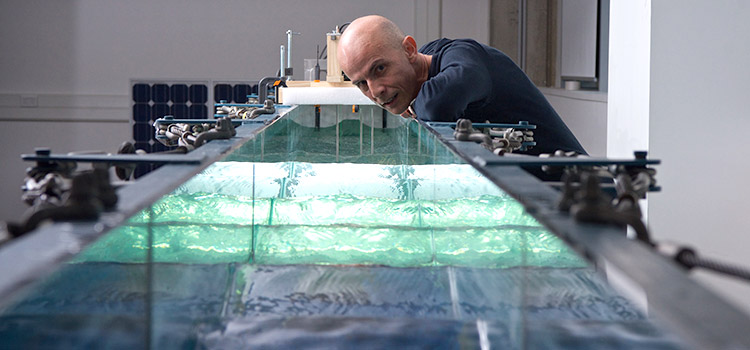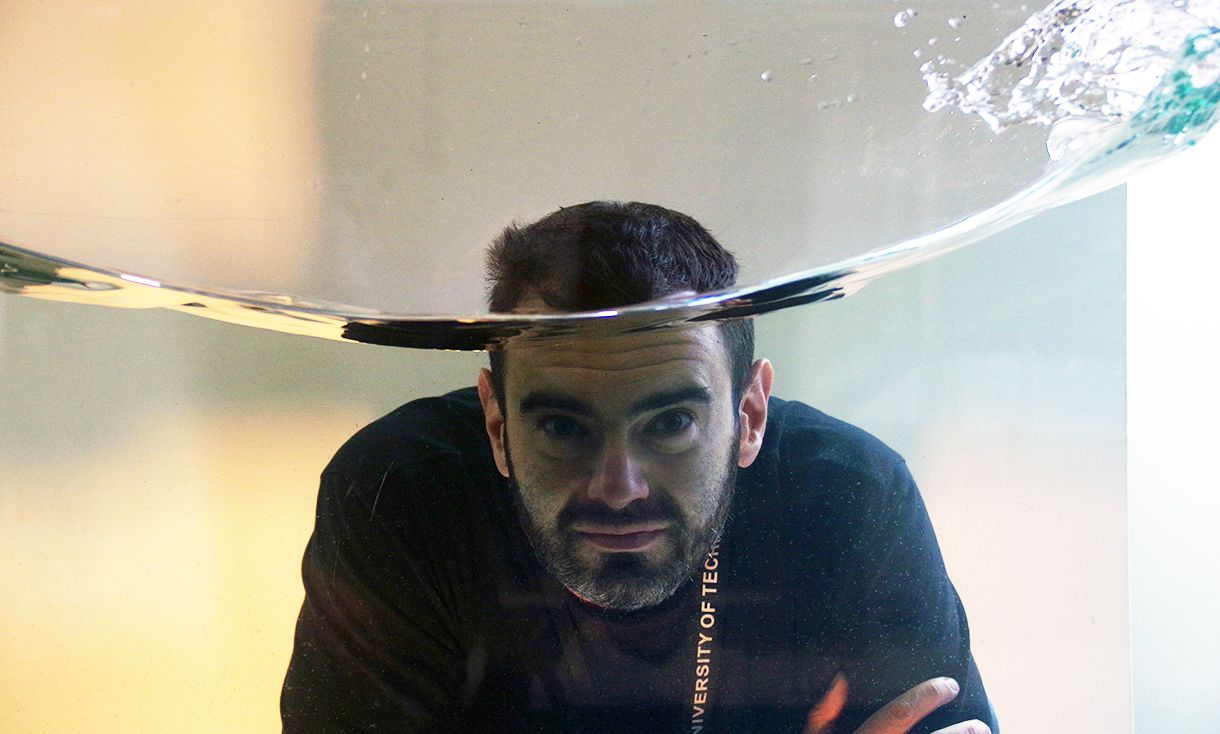Surf sounds study to investigate bubble size data for industrial and environmental use

Professor Richard Manasseh will use the wave channel in Swinburne’s Energy Transformation Lab to study the dynamics of bubbles in waves.
In summary
- Swinburne researchers are studying the sound dynamics of bubbles in waves
- These sounds contain valuable data that has applications in many industries as well as in determining how much carbon dioxide the Earth’s oceans are absorbing
- Elissa Goodrich will work with the Surf Sounds team to create new music and sound art
From the ‘plink’ of a single drop of liquid falling into a glass of water to the roar of ocean surf, the formation of bubbles makes sounds familiar to everyone.
These sounds contain valuable data on bubble sizes and numbers that have applications not only in many different industries, but also in determining how much carbon dioxide the Earth’s oceans are absorbing.
Funded by a $525,000 Australian Research Council Discovery Project grant, Swinburne University of Technology researchers are studying the dynamics of bubbles in waves.
“We think that bubbles in breaking ocean waves facilitate the absorption of up to a third of global carbon dioxide emissions, but the true fraction the ocean absorbs is poorly understood, adding to uncertainty in climate-change models,” says lead researcher Professor Richard Manasseh.
“Bubble size also matters in industries that rely on pumping air into liquid, including processed-food and pharmaceuticals manufacturing, rare-earth metals refining and recycling.”
Bubble size controls the rate with which oxygen or other gases are absorbed by water or other liquids. At present measuring bubble size is virtually impossible in most practical industrial and environmental situations.

Dr Filippo Nelli is working on simple lab experiments to understand the relationship between the size of bubbles and the sound amplitude made as they are formed.
The relationship between bubble size and sound frequency – the ‘pitch’ of the ‘musical note’ made by bubbles – has been understood since the 1930s, but uncertainty on the sound amplitude or volume has made sound recordings impossible to interpret.
Dr Filippo Nelli has been recruited as a postdoctoral researcher and is working on simple lab experiments to understand the relationship between the size of bubbles and the sound amplitude made as they are formed. The study of five different bubble formation processes will create a database.
At the same time, Professor Andrew Ooi at the University of Melbourne will use a supercomputer to simulate numerically what is being measured in the lab.
The goal is to develop instruments to monitor these processes, permitting their ultimate control.
“Australian instrument manufacturers would gain a potential new product and Australian minerals, food, pharmaceutical and environmental-monitoring industries would be the first to benefit,” Professor Manasseh says.
Waves music project
In a creative adjunct to the Surf Sounds project, Melbourne composer, sound artist and musician Elissa Goodrich has been awarded an Australia Council for the Arts grant to work on a musical interpretation of the bubble acoustics research. Ms Goodrich specialises in using music to interpret science for the public and was recently made a Swinburne Visiting Fellow.

Elissa Goodrich will work with the Surf Sounds scientific team to create new music and sound art that conveys climate science's vital themes and modellings of tipping points and thresholds.
“I am very excited to be able to work as an embedded artist with Richard's Surf Sounds project and to be doing this in a longitudinal approach,” Ms Goodrich says.
As her musical composition ideas develop, she will introduce a small ensemble of musicians with expertise in contemporary improvised music, to develop a full length musical work for live contemporary jazz/classical ensemble and electro-acoustic sound art.
-
Media Enquiries
Related articles
-

- Technology
- Science
- Engineering
Victorian students drive green energy transition through international hydrogen competition
Swinburne’s KIOSC, in collaboration with Horizon Educational and Gippsland Tech School, co-hosted the Hydrogen Grand Prix in Melbourne.Friday 26 July 2024 -

- Technology
- Health
New MedTechVic prototypes to transform everyday lives of people with a disability
Swinburne’s MedTechVic has revealed three new prototypes designed through the joint Health-led Manufacturing Innovation Program, in partnership with the Australian Medtech Manufacturing Centre and Safer Care Victoria
Friday 19 July 2024 -

- Science
Skin, scales and fish tails: using collagen to turn fish guts into gold
New research from Swinburne could transform the sector by converting high value collagen proteins from seafood by-products into cosmetics, food, and pharmaceuticals.
Tuesday 02 July 2024 -

- Education
- Engineering
Transforming the lives of refugee engineers through the EPIC Program
Swinburne has been partnering with the Level Crossing Removal Project (LXRP) on the Engineering Pathway Industry Cadetship (EPIC) program, helping refugee engineers gain international qualifications for the Australian workforce through an 18-month paid cadetship program.
Thursday 20 June 2024 -

- Science
- Engineering
Submarines in the future could self-identify cracks and self-heal thanks to Swinburne researcher
Thanks to the work of Dr Nisa Salim from Swinburne University of Technology’s School of Engineering, future submarines could self-identify microcracks and self-heal using a new kind of carbon fibre reinforced polymer composites.
Monday 17 June 2024

